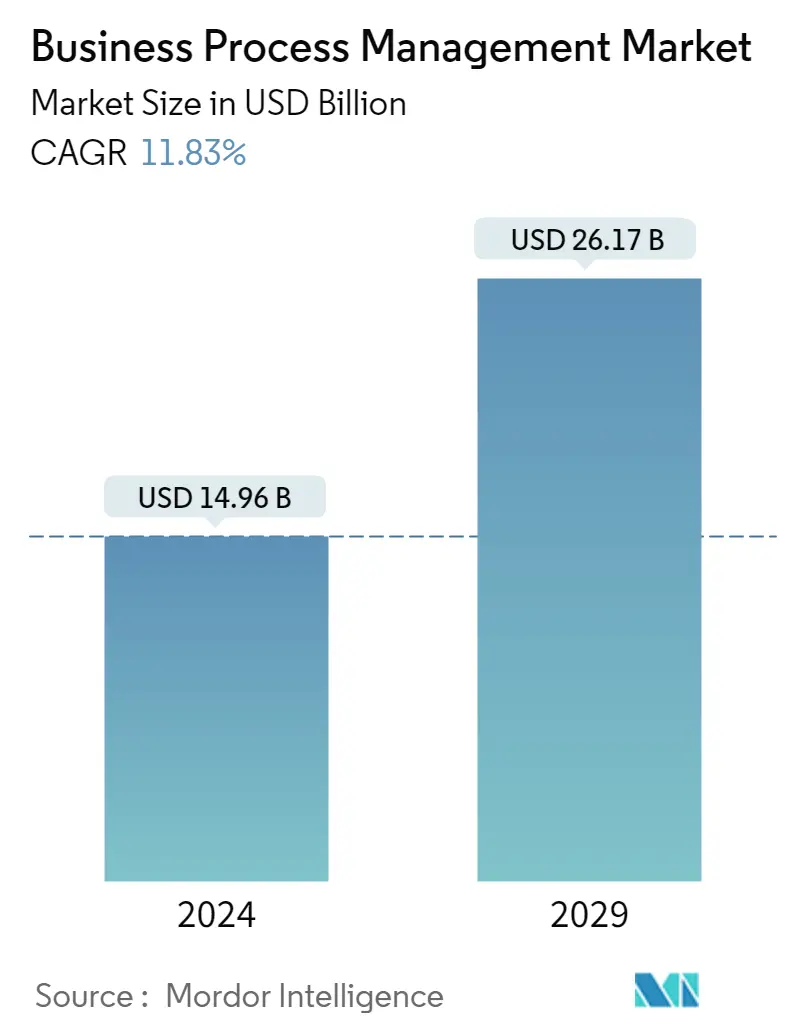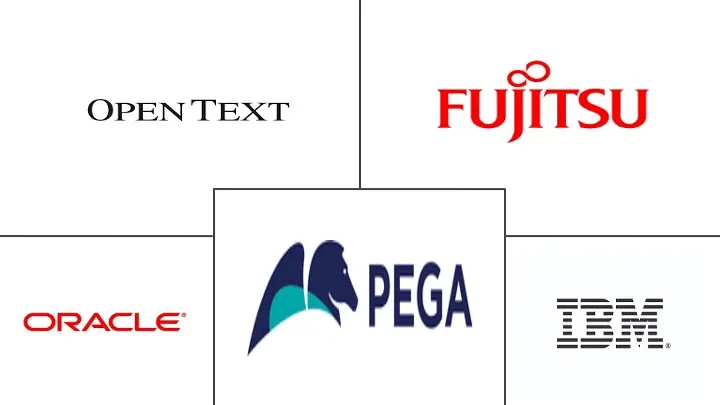Market Size of Business Process Management Industry

| Study Period | 2021 - 2029 |
| Market Size (2024) | USD 14.96 Billion |
| Market Size (2029) | USD 26.17 Billion |
| CAGR (2024 - 2029) | 11.83 % |
| Fastest Growing Market | Asia Pacific |
| Largest Market | North America |
Major Players
*Disclaimer: Major Players sorted in no particular order |
Business Process Management (BPM) Market Analysis
The Business Process Management Market size is estimated at USD 14.96 billion in 2024, and is expected to reach USD 26.17 billion by 2029, growing at a CAGR of 11.83% during the forecast period (2024-2029).
- In recent years, business process management (BPM) has received considerable attention due to its potential to increase productivity and significantly reduce costs. These are generic software systems driven by specific process designs that enact and manage operational business processes.
- Business process management (BPM) is a systematic process of optimizing organizations' approaches to complete tasks, provide customers, and earn revenue. A business process is an activity or series of operations that assist an organization in achieving its objectives, such as raising revenues or boosting workforce diversity. BPM analyses a business process, models how it operates in multiple scenarios, implements modifications, monitors the new approach, and continuously improves its ability to produce desired business objectives and results.
- The market also witnessed trends concerning enabling the companies (end users) to build their applications. Most of the vendors in the market studied are leading to Low-code App Development capabilities. With BPM platforms required to integrate all the collaboration functionalities, like content and file sharing, internal communication, personnel management, and issue management, among others, the development of low-code applications has been a significant breakthrough.
- For instance, IBM's Intelligent business process management suites (iBPMS) offer business process management (BPM) software with additional capabilities, such as artificial intelligence (AI). It is mainly designed to assist companies in the dynamic automation of workflows. These suites are often cloud-enabled and provide low-code tools that help developers create workflow solutions quickly and easily.
- One of the significant trends in the BPM market includes the transition towards positioning themselves as low-code platform providers. This development is expected to increase the fragmentation of the BPM market.
- A few use cases identified as enterprise selection criteria include digital business optimization and transformation, self-service intelligent business process automation, and adaptive case management.
- The key players in the market are focusing on strategic collaborations and improving their services by launching new solutions into the market. For instance, this year, OpenText announced that it had signed a deal for the total issued and to be issued share capital of Micro Focus for 532 pence per share (the acquisition) through its wholly-owned subsidiary, OpenText UK Holding Limited (Bidco), implying an enterprise value of approximately USD 6.0 billion.
- This year, TIBCO announced the availability of TIBCO CloudTM EBX, an innovative and powerful master data management (MDM) software-as-a-service (SaaS) solution. TIBCO Cloud EBX allows customers to manage business data from anywhere, including the master, reference, and metadata. As a SaaS product, EBX now provides customers with self-service access to cloud-native MDM features for faster and wiser implementation. The solution is part of the TIBCO CloudTM Passport. This new consumption-based pricing plan offers flexible FinOps (financial operations) access to all TIBCO SaaS capabilities under a single model.
- As the demand for business process management is directly related to the need for process automation in different sectors, the higher the demand for process automation around the world, the higher the demand for business process management solutions. These factors help organizations and vendors focus on entering the business process management market, as their core competency results in organizations' overall growth.
- The fragility of supply networks has been exposed with the commencement of COVID-19. The fragile ecosystem includes providers of vital IT services for most IT firms. Furthermore, work-from-home mandates have prompted service providers to guarantee that mission-critical enterprise customers have the tools and technology to improve the speed, security, quality, and overall efficacy of services supplied, promoting the market growth.
- In the post-pandemic scenario, increasing the adoption of digitalization and new technologies drives growth in the market. BPM helps optimize and allows businesses to implement new solutions to support application cases.
Business Process Management (BPM) Industry Segmentation
Business process management (BPM) is a discipline that involves a combination of process modeling, automation, execution, control, measurement, and optimization of the business process flows in the alignment of the enterprise goals, spanning systems, employees, customers, and business partners.
The scope of the study focuses on the market analysis of business process management solutions across the globe, and market sizing encompasses the revenue generated by the solutions sold by various market players. The study also tracks the key market parameters, underlying growth influencers, and major vendors operating in the industry, which supports the market estimations and growth rates over the forecast period. The study further analyzes the overall impact of COVID-19 on the ecosystem.
The business process management market is segmented by deployment (on-premises and cloud), solution (process management, process automation, content and document management, case management, and other solutions (optimization management and application integrations)), end-user industry (banking, financial services, and insurance (BFSI), government and defense, healthcare, it and telecommunication, retail, manufacturing, and other end-user industries (energy, education, etc.), and geography (North America, Europe, Asia Pacific, Latin America, Middle East, and Africa).
The market sizes and forecasts are provided in terms of value (USD billion) for all the above segments.
| By Deployment | |
| Cloud | |
| On-premise |
| By Solution | |
| Process Improvement | |
| Process Automation | |
| Content and Document Management | |
| Case Management | |
| Other Solutions (Optimization Management and Application Integrations) |
| By End-User Industry | |
| Banking, Financial Services, and Insurance (BFSI) | |
| Government and Defense | |
| Healthcare | |
| IT and Telecommunication | |
| Retail | |
| Manufacturing | |
| Other End-user Industries (Energy, Education, etc.) |
| By Geography | |
| North America | |
| Europe | |
| Asia Pacific | |
| Latin America | |
| Middle East and Africa |
Business Process Management Market Size Summary
The Business Process Management (BPM) market is experiencing significant growth, driven by the increasing need for organizations to enhance productivity and reduce operational costs. BPM involves the systematic optimization of business processes to achieve organizational goals, such as revenue generation and improved workforce diversity. The market is witnessing a shift towards low-code application development, enabling companies to build their applications with ease. This trend is supported by advancements in BPM platforms that integrate collaboration functionalities and offer tools for rapid workflow solution development. Key players in the market, such as IBM and TIBCO, are enhancing their offerings with artificial intelligence and cloud-enabled solutions, further propelling market expansion.
The demand for BPM solutions is particularly strong in sectors like banking, financial services, and insurance, where organizations rely on technology to streamline processes and optimize resources. The COVID-19 pandemic has highlighted the fragility of supply networks, prompting a greater focus on digitalization and process automation. BPM tools are essential for automating various banking operations, such as loan processing and customer inquiries, helping institutions manage complexity and improve decision-making. The competitive landscape of the BPM market is marked by intense rivalry, with companies engaging in mergers, acquisitions, and product innovations to maintain their market positions. Recent developments include the launch of low-code capabilities and AI-driven solutions, which are set to further transform the BPM industry.
Business Process Management Market Size - Table of Contents
-
1. MARKET DYNAMICS
-
1.1 Market Drivers
-
1.1.1 Demand for Low-code Systems
-
1.1.2 Increasing Efficiency of Predictable Tasks (Adaptive Case Management)
-
1.1.3 Bots and AI Across Manufacturing Domain
-
-
1.2 Market Challenges
-
1.2.1 Automation Becoming Costly and Low ROI Proposition
-
1.2.2 Integration Failures
-
-
-
2. MARKET SEGMENTATION
-
2.1 By Deployment
-
2.1.1 Cloud
-
2.1.2 On-premise
-
-
2.2 By Solution
-
2.2.1 Process Improvement
-
2.2.2 Process Automation
-
2.2.3 Content and Document Management
-
2.2.4 Case Management
-
2.2.5 Other Solutions (Optimization Management and Application Integrations)
-
-
2.3 By End-User Industry
-
2.3.1 Banking, Financial Services, and Insurance (BFSI)
-
2.3.2 Government and Defense
-
2.3.3 Healthcare
-
2.3.4 IT and Telecommunication
-
2.3.5 Retail
-
2.3.6 Manufacturing
-
2.3.7 Other End-user Industries (Energy, Education, etc.)
-
-
2.4 By Geography
-
2.4.1 North America
-
2.4.2 Europe
-
2.4.3 Asia Pacific
-
2.4.4 Latin America
-
2.4.5 Middle East and Africa
-
-
Business Process Management Market Size FAQs
How big is the Business Process Management Market?
The Business Process Management Market size is expected to reach USD 14.96 billion in 2024 and grow at a CAGR of 11.83% to reach USD 26.17 billion by 2029.
What is the current Business Process Management Market size?
In 2024, the Business Process Management Market size is expected to reach USD 14.96 billion.

